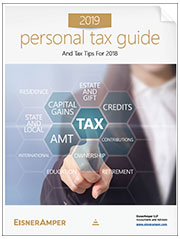
2019 Personal Tax Guide and Tax Tips for 2018
- Published
- Apr 4, 2019
- By
- Marie Arrigo
- Topics
- Share
 INTRODUCTION: TAX CUTS AND JOBS ACT IN FULL EFFECT
INTRODUCTION: TAX CUTS AND JOBS ACT IN FULL EFFECT
On December 22, 2017, the Tax Cuts and Jobs Act of 2017 (“TCJA”) was signed into law by President Trump. The TCJA is the most significant piece of tax legislation since the Tax Reform Act of 1986, and has broad impact on all aspects of the American economy, including individuals, businesses and not-for-profits. It also impacts multinationals and international transactions. The provisions of the new law are in full effect, with some provisions scheduled to expire after December 31, 2025.
Some of the major provisions include:
- The top individual tax rate is now 37%, down from 39.6% in 2017. The top long-term capital gains tax remains at 20% and there is no change to the 3.8% Medicare Contribution Tax on net investment income, nor the 0.9% Health Insurance Tax on earned income for higher income individuals.
- The top rate of 28% for alternative minimum tax (“AMT”) for individuals remains the same. However, it is anticipated that less people will be subject to the AMT since many of the factors that caused the AMT previously are no longer an issue.
- For individuals, the standard deduction almost doubles from that in effect in 2017, while itemized deductions are either eliminated or scaled back. State/local income and property tax deductions are limited to $10,000 for years beginning after December 31, 2017 and ending before January 1, 2026. All miscellaneous itemized deductions that are subject to the 2% adjusted gross income (“AGI”) limit are repealed for tax years 2018-2025. These expenses included investment advisory fees, accounting and legal fees, and unreimbursed employee business expenses. Home mortgage interest expense is limited to interest on acquisition debt for tax years 2018-2025, with the maximum amount that may be treated as acquisition debt reduced to $750,000 (from $1 million) and applied to any acquisition debt incurred after December 15, 2017. The $1 million threshold for acquisition indebtedness incurred prior to December 15, 2017 is still in effect. Interest paid on home equity debt of any qualified residence is not deductible except for loans used to buy, build or substantially improve the taxpayer’s home that secures the loan.
- Charitable contribution deductions remain a viable itemized deduction. The TCJA increased the percentage of an individual’s AGI limitation that may be deducted for cash contributions to public charities and other certain tax-exempt entities to 60%, up from 50%. However, because of the way in which the law is written, contributions of other property and to other exempt organizations (such as private foundations) can scale back the amount of the charitable deduction allowed. Because of the increase in the standard deduction and the scaling back of itemized deductions, many individuals will not be itemizing on their returns starting in 2018. Thus, such taxpayers will lose the benefit of their charitable contributions.
- The TCJA has increased the estate, gift, and generation-skipping transfer tax exclusions from $5 million to $10 million, indexed annually for inflation. The inflation-adjusted exclusion for 2019 is $11.4 million per person, or $22.8 million per married couple. The top estate and gift tax rate remains at 40%.
- The top tax rate for C corporations is now at 21%, a decrease from 35% in 2017.
- The AMT for corporations has been permanently repealed for tax years beginning after December 31, 2017.
- There is a new qualified business income deduction of up to 20% for pass-through entities, such as partnerships, limited liability companies, S corporations and sole proprietors. The deduction is generally limited to the greater of (1) 50% of the W-2 wages paid by the business or (2) the sum of 25% of the W-2 wages paid plus 2.5% of the unadjusted basis of certain property the business uses to produce qualified business income. Certain other limitations apply.
- Some U.S. taxpayers may be required to pay a one-time transition tax on the untaxed earnings of certain specified foreign corporations. Taxpayers reporting such income are allowed a “participation exemption” under IRC Sec. 965, which reduces the federal tax rate on repatriation income. Individuals can elect to pay the tax on such income over eight years. In the case of S corporations, the taxpayer can elect to defer the tax liability on such income until a specified triggering event occurs. IRC Sec. 965 income was reportable for most taxpayers on their 2017 federal income tax return while the Global Intangible Low Taxed Income (“GILTI”) is generally first applicable for tax years beginning on or after December 1, 2017. These provisions required taxpayers to recognize deemed income prior to the actual receipt of such income. There also may be state tax implications.
- The TCJA affords businesses with the new Family and Medical Leave Tax Credit. For 2018 and 2019, an employer can claim a tax credit for a portion of the wages it pays to employees for any period during which those employees are on leave.
In addition, a noteworthy Supreme Court decision may impact many taxpayers.
The U.S. Supreme Court’s Wayfair decision has impacted taxation of e-commerce. Prior to this decision, states could generally only subject an out-of-state seller to sales tax if it had “physical presence” in that state. While physical presence could be a permanent physical establishment in a state, it could also be established through agents, affiliates, employee visits and/or online marketing agreements or software such as “cookies” in a state. The Supreme Court overturned the physical presence requirement and found that economic nexus provisions enacted in the state of South Dakota were valid. As a result, approximately 38 states now have some type of economic nexus provisions regarding sales tax. Many companies which previously had filing requirements in one or two jurisdictions now find themselves with new collection and filing requirements in 35+ states.
The international arena continues to be of great concern to many individuals and families. The global threat of terrorism, the investigation of Russia over interference with U.S. election proceedings, the uncertainty over North Korea and whether they have resumed nuclear activities in light of the recent failed talks with the U.S., as well as potential trade wars resulting from U.S. imposed tariffs on certain imports continue to be significant issues.
The concerns over border security led to the longest shutdown of the government ever. The U.S. partial shutdown began on December 22, 2018 and ended 35 days later with a short-term funding bill. The House of Representatives proposed a budget with some border security funding, which the President signed. The President then declared the situation on the southern border of the United States to be a national emergency, asking for $8.6 billion. The House voted to block the national emergency declaration, and the Senate did the same, setting the stage for the President’s first veto. This action is catapulting country into uncertain legal and political battles as President Trump seeks to fulfill a campaign promise that has eluded him for two years.
Many families with wealth are very concerned about their children’s and grandchildren’s future, and wonder what can be done to sustain and grow their wealth in these uncertain times. Given the impact of new legislation and the current economic and geopolitical landscape, it is extremely important that you pay attention to your financial position so that you can achieve your financial objectives. Specific goals such as retirement planning, managing cash flow, and transferring your family’s wealth to the next generation should be top-of-mind in 2019 and beyond.
We have written this guide to provide you with a tool to identify opportunities to minimize tax exposure, accomplish your financial goals and preserve your family’s wealth. This guide includes all major law changes through March 10, 2019. The best way to use this guide is to identify areas that may be most pertinent to your unique situation and then discuss the matter with your tax advisor. It is especially important that you check in with your tax advisor before proceeding with any tax planning transactions this year. As always, our tax professionals will be pleased to discuss any of the ideas in this guide or any other planning opportunities which might apply to your personal situation.
|
|
Browse this years Tax Guide
| 2019 Personal Tax Guide | |
| chapter | Table of Contents– download by chapter |
| 1 | Tax Planning Strategies |
| 2 | Tax Rate Overview |
| 3 | Estimated Tax Requirements |
| 4 | Alternative Minimum Tax |
| 5 | Business Owner Issues and Depreciation Deductions |
| 6 | Capital Gains and Dividend Income |
| 7 | Stock Options, Restricted Stock and Deferred Compensation |
| 8 | Small Business Stock |
| 9 | Passive and Real Estate Activities |
| 10 | Principal Residence Sale and Rental |
| 11 | Charitable Contributions |
| 12 | Interest Expense |
| 13 | Retirement Plans |
| 14 | Estate and Gift Tax Planning |
| 15 | Tax Credits |
| 16 | Education Incentives |
| 17 | International Tax Planning and Reporting Requirements |
| 18 | State Tax Issues |
| Appendices | |
| Appendix A | 2019 Federal Tax Calendar for Individual Taxpayers |
| Appendix B | 2018 Federal Tax Rate Schedule |
| Appendix C | 2019 Federal Tax Rate Schedule |
| Appendix D | 2018 Maximum Effective Rates |
| Appendix E | 2019 Maximum Effective Rates |
| Appendix F | 2019 Federal and State Tax Returns Due Dates |
| Appendix G | EisnerAmper Tax and Private Business Services Partners and Principles |
Editor-in-Chief: Marie Arrigo
Managing Editors: Tom Hall, Dan Gibson, Robert Levin
Co-Editors: Gary Bingel, Angela Chen, Denise DeLisser, Carolyn Dolci, Howard Liu, Kurt Peterson, Ken Weissenberg
Contributors: Jonathan Acquavella, June Albert, Peter Alwardt, Ben Aspir, Paul Bleeg, Lina Chan, Cindy Feder, William Gentilesco, Cindy Huang, Sue Huang, Jean Jiang, Seth Komitzky, Cindy Lai, Kevin Sohr, Jeanne Marie Waldman, Holly Wong
This tax guide highlights tax planning ideas that may help you minimize your tax liability. This guide does not constitute accounting, tax, or legal advice, nor is it intended to convey a thorough treatment of the subject matter. The best way to use this guide is to
identify those issues which could impact you, your family, or your business and then discuss them with your tax advisor.
The discussion in this guide is based on the Internal Revenue Code as amended through March 10, 2019. Future legislation, administrative interpretations, and judicial decisions may change the advisability of any course of action. Because of periodic legislation changes, you should always check with your tax advisor before implementing any tax planning ideas.
Any tax advice contained in this publication (including any attachments) is not intended for and cannot be used for the purpose of (i) avoiding penalties imposed by the Internal Revenue Code or (ii) promoting, marketing, or recommending any transaction or matter addressed herein.
© Copyright 2019 by EisnerAmper. All rights reserved. This book, or portions thereof, may not be reproduced in any form without permission of EisnerAmper.
What's on Your Mind?
Start a conversation with Marie
Receive the latest business insights, analysis, and perspectives from EisnerAmper professionals.













